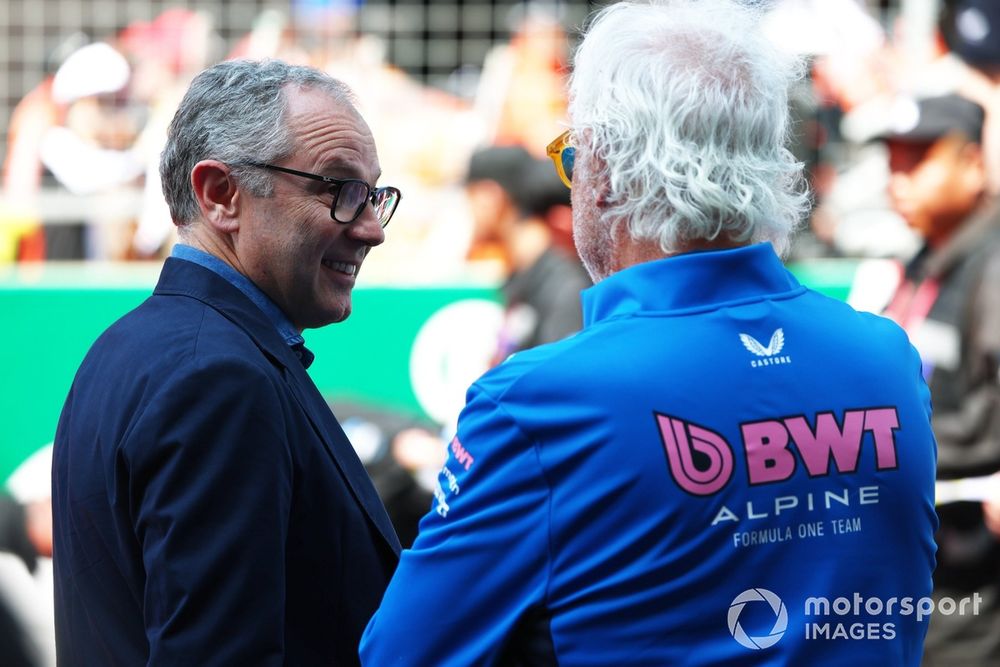Formula 1 CEO Stefano Domenicali wants to ensure that 2026’s rules changes are explained in “simple terms” across the media to preserve the championship’s appeal to casual audiences.
Next year’s regulations affect both the chassis and powertrain; F1 cars will be smaller next season, with active aerodynamics and further commitment to hybridisation. This includes a near-50/50 split between the outputs of the internal combustion engine and motor generator unit (closer to 53/47), with provision for an overboost system that will operate as a replacement for DRS.
There have been many concerns raised by teams and drivers regarding the level of management required from the new powertrains, with others fearing a repeat of 2014 – where Mercedes stole a considerable march over Ferrari and Renault with its first turbo-hybrid powertrain.
Domenicali is not convinced that there will be a runaway leader next term, but certainly feels that F1 has room to improve in communicating the changes for next season – particularly when it comes to ensuring that everyone watching understands the basics of the new rules.
He says that using simplified language to describe the technical changes for 2026 should help F1 in retaining and on-boarding new fans.
“There’s a very important topic looking ahead to next season. We’ll have a major rules change, and it will be crucial to explain all the technical and regulatory novelties on the cars in simple terms,” Domenicali told select media, including Autosport.
2026 Formula 1 rules
Photo by: FIA
“This has to be planned in a structured, easy-to-understand way. Today we have many more ‘casual fans’ who don’t know what’s under the bodywork, and for this audience a change of this scale won’t be easy to grasp.
“Together with our colleagues at the [FIA] and the teams’ representatives, we’re considering a meeting with the media to work out the best way to explain, in simple terms, what we’ll see on track next season.
“At first, with short ‘pills’, including graphics, to show what the car is, how it works and what the drivers will need to get used to. This will be crucial, because in recent months everything and more has been said about next year’s rules – sometimes instrumentally; that’s part of the game.
“We don’t want to use engineers’ language; we have to be practical, basic. I have to understand it myself; if I get it, then it’s fine.
“We can’t ignore that many new fans are entering F1 who don’t know this world, so it’s our duty to simplify the language and explain what will happen. We’ll have to explain it very, very well.”
Domenicali confirms post-Monza meeting on F1 2030 plans
According to Domenicali, there will be a meeting after the Italian Grand Prix to discuss powertrain plans for 2030; it is known that the FIA favours the reduction of hybridisation and a naturally aspirated engine using sustainable fuels.

Stefano Domenicali, CEO of the Formula One Group talks with Flavio Briatore, Executive Advisor of Alpine F1
Photo by: Sam Bloxham / Motorsport Images
Domenicali agrees that “excessive” hybridisation means that it is difficult to reduce the weight and size of the cars, the regulations need to ensure that it sufficiently interests the current manufacturers – and potentially tempt new players to join.
“I share the FIA’s view: sustainable fuels are central, and excessive electrification only leads to heavier cars, greater complexity and larger dimensions which, frankly, I don’t think are so interesting.
“If we keep a form of hybridisation and safeguard sustainability with the new generation of fuels, then discussing a new engine is, I think, correct.
“The goals are to reduce teams’ running costs; sustainable fuels and hybridisation will still meet manufacturers’ needs; and we also want to guarantee the greatest possible independence should there be another crisis in the automotive sector.
“We want to keep the big carmakers with us, so the goal is to offer a technological project that interests them while also making it possible, if needed, to create a sort of ‘Formula 1’ engine that can protect us at any time from potential downturns.
“The preference is obviously to keep the major manufacturers we have – and maybe attract new ones. We’ll have Audi, Cadillac, Honda will return, and Toyota is monitoring the situation.”
In this article
Be the first to know and subscribe for real-time news email updates on these topics

